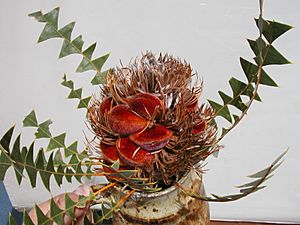Baxter's banksia facts for kids
Quick facts for kids Baxter's banksia |
|
|---|---|
 |
|
| Banksia baxteri in Kings Park, Western Australia | |
| Scientific classification |
Baxter's banksia (also called the bird's nest banksia) is a special type of shrub. It only grows in Western Australia. This plant has rough, grey-brown bark and fuzzy stems. Its leaves are deeply cut with pointy edges. It grows bright lemon-yellow flowers in an oval shape at the end of its branches.
Contents
What Does Baxter's Banksia Look Like?
Baxter's banksia is a tall, upright shrub. It usually grows between 1 and 5 meters (about 3 to 16 feet) high. Unlike some other plants, it doesn't have a special woody lump underground called a lignotuber.
When young, its small branches and leaves are covered in soft, white hairs. Its leaves are shaped like a wedge. They are 7 to 17 centimeters (about 3 to 7 inches) long. The leaves are deeply divided with four to seven pointy sections on each side.
The flowers grow in a broad, oval shape at the ends of the branches. These flower spikes are about 7.5 to 8.6 centimeters (about 3 to 3.4 inches) wide. Each individual flower is lemon-yellow. Baxter's banksia usually flowers from December to May, but mostly from January to March. After flowering, only a few seed pods, called follicles, develop. These pods are about 3.5 to 4.2 centimeters (about 1.4 to 1.7 inches) long.
How Baxter's Banksia Got Its Name
The plant Banksia baxteri was first officially described in 1830. A botanist named Robert Brown gave it its scientific name.
The first samples of the plant were collected in 1829. They were found by another botanist, William Baxter. He found them in the mountains near King George Sound. This is why the plant is named "baxteri" after him.
Where Does Baxter's Banksia Grow?
Baxter's banksia grows alongside other shrubs. It often grows in deep sand. You can usually find it within 50 kilometers (about 30 miles) of the coast. Its home stretches between East Mount Barren and Israelite Bay.
Is Baxter's Banksia Endangered?
The Western Australian Government's Department of Parks and Wildlife has looked at Baxter's banksia. They have classified it as "not threatened." This means it is not currently in danger of disappearing.
How Baxter's Banksia Survives and Thrives
Scientists have studied Baxter's banksia to learn how it grows. A study in 1980 showed that birds help pollinate its flowers. The New Holland honeyeater and white-cheeked honeyeater are two types of birds that visit these plants. They help carry pollen from one flower to another.
Baxter's banksia is a special type of plant called "serotinous". This means it keeps its seeds safe in its canopy (the top part of the plant). The seeds are stored inside the tough, woody follicles on the old flower spikes. These pods only open when there is a fire. The heat from the fire makes the pods release their seeds. After the fire, when it rains, the seeds can then sprout and grow. This helps new plants grow in areas that have been burned. The seeds can stay good for many years. Even old spikes that are 9 to 12 years old can still have seeds that will grow.
Growing Baxter's Banksia at Home
If you want to grow Baxter's banksia from seeds, it's quite easy. The seeds don't need any special treatment to help them sprout. They usually take about 21 to 42 days to germinate (start growing).
Images for kids
- Taylor, Anne; Hopper, Stephen (1988). The Banksia Atlas (Australian Flora and Fauna Series Number 8). Canberra: Australian Government Publishing Service. ISBN 0-644-07124-9.



